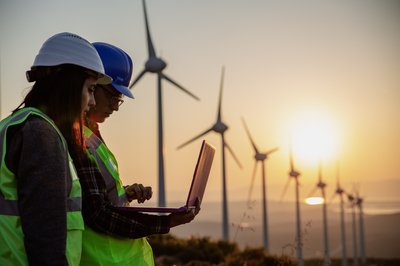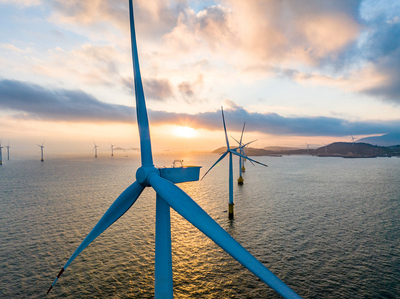Discover the critical challenges and promising future of the offshore wind sector, including insights on supply chain coordination, investor confidence, and talent acquisition, and understand why a strategic recalibration is essential for achieving long-term success.

2. Global Policy Impact on Offshore Wind
Offshore wind stands at the crossroads of geopolitical ambition, climate policy, and economic reality. As a capital-intensive sector highly dependent on policy stability and international cooperation, it is uniquely sensitive to shifts in political mood and regulatory posture. The industry’s global prospects are increasingly shaped not just by market dynamics, but by the long-term political will and policy coherence of individual nations.
2.1 The U.S. Policy Reversal: A Disruptive Signal for That Regional Market and the Implications Beyond
The recent Executive Order from President Trump, freezing new offshore wind leasing on the U.S. Outer Continental Shelf and triggering a federal permitting review, landed with all the subtlety of a thunderclap. It was more than a course correction—it was a sharp turn against one of the world’s most promising clean energy markets.
The implications go well beyond U.S. shores. For developers such as Ørsted and RWE, the pivot disrupts more than local timelines; it shakes assumptions baked into global investment strategies. The offshore wind industry does not operate in silos—capital, components, and capability move fluidly across borders. A slowdown in one major market sends tremors through the globally exposed developers.
“Every major developer has a stake in the US. When a key market like this wobbles it hits balance sheets in Europe too,” Prasoon Kumar explains. “That, in turn, influences global investment decisions.”
As the U.S. faces policy uncertainty, Matthias Bausenwein notes a positive impact on Europe, where countries (including the UK) “have become more collaborative since,” recognising that joint efforts are key to accelerating offshore wind development and securing shared success.
While offshore wind markets remain regional, the challenges in the U.S. could actually benefit Europe’s supply chain, as the pressure on capacity may not be as intense.
Scale was always the sector’s best bet for driving costs down. The U.S. build-out was meant to be a keystone in that equation—offering volume, standardisation, and political tailwinds. Instead, the industry now faces the opposite: policy whiplash, dampened demand signals, and greater exposure to macroeconomic risk.
For a sector still working to prove its resilience in the U.S., this isn’t just a speed bump—it’s a strategically expensive detour.
“Offshore wind is not oil and gas with turbines. It’s a power business—capital-heavy, margin-thin, and execution-critical.”
Philippe Kavafyan
2.2 A Utility Business, Not a Speculative One
“Offshore wind is not oil and gas with turbines. It’s a power business—capital-heavy, margin-thin, and execution-critical.” — Philippe Kavafyan, Windfluencer and former CEO at MHI Vestas Offshore Wind.
A key reason offshore wind is under such pressure lies in the fundamental misalignment between how the sector was structured and how it operates economically.
Historically, offshore wind borrowed its operational mindset—and many of its professionals—from offshore oil and gas. This brought technical expertise but also transplanted expectations of high project returns, equity-driven growth, and capital-heavy speculative development. Developers were often rewarded not for generating power efficiently, but for trading stakes in projects, leading to inflated valuations and aggressive assumptions.
That model has run into a post-COVID wall. Inflation, interest rate hikes, and supply chain volatility have eaten away at margins. Projects that once appeared bankable are now being mothballed, equity valuations have plummeted, and layoffs have hit across the industry.
Offshore wind was never meant to behave like an extractive venture but as a utility business—one where cost discipline, operational efficiency, and predictable long-term returns matter more than speculative upside. This means moving away from boom-era exuberance and toward a model built on operational rigour, financial prudence, and strategic patience.
Without a structural shift—from speculative ambition to measured delivery—the industry risks emulating the volatility of the very system it aims to displace.

2.3 Europe: Still the Centre of Gravity?
While policy turbulence rattles other markets, Europe remains offshore wind’s gravitational core. Its commitment to decarbonisation isn’t just rhetorical—it’s codified in law, reinforced by binding climate targets, and enabled by cross-border regulatory alignment. Countries like the UK, Denmark, the Netherlands, and Germany continue to back the sector with stable policy, auction-based incentives, and investment in enabling infrastructure.
Echoing this, Matthias Bausenwein remains optimistic on Europe, stating, “In all relevant offshore wind markets like The Netherlands, Germany, Denmark and the United Kingdom there will be attractive market opportunities,” particularly as governments are beginning to adjust and improve their frameworks in response to recent failed auctions.
Europe’s enduring appeal rests on three structural advantages:
- Strong Government Backing: Policy frameworks remain broadly stable, with continued political consensus—even across ideological divides.
- Deep Industrial Capability: Europe’s mature supply chains, specialised ports, and highly skilled workforce offer a level of operational resilience few regions can match.
- Systemic Integration: Offshore wind in Europe is no longer viewed in isolation—it is increasingly integrated with broader strategies around hydrogen, cross-border interconnectors, and grid flexibility.
However, recent challenges in auction rounds (e.g. UK Round 5 and Danish tenders) underscore the need for governments to adapt their expectations to changing economic realities.
Philippe Kavafyan stresses, "For offshore wind to scale up sustainably, it requires political and regulatory stability. With project timelines spanning a decade for planning/permitting and 3–5 years after FID for construction, these multi-billion-dollar investments need predictable frameworks. Ultimately, whilst capital for offshore wind exists, investors seek returns that the sector is currently struggling to promise due to the volatile power market, hence the importance of PPAs and CFDs from the policy landscape."
2.4 Beyond Europe: The Rise of Regional Heavyweights
Europe may still be the heartland of offshore wind, but the next wave of momentum is clearly building elsewhere. Asia-Pacific, in particular, is emerging as a key battleground for scale, speed, and strategic dominance. Countries like Japan, South Korea, Taiwan, and Australia are setting firm offshore wind targets, backed by public incentives, industrial policy, and increasingly sophisticated local supply chains.
And then there’s China—now leading the world in installed offshore wind capacity, thanks to a combination of aggressive policy mandates, streamlined permitting, and heavy industrial investment.
Three lessons stand out:
- Scale and Speed: China’s ability to mobilise capital and coordinate supply chains enables it to deliver projects at a pace unmatched by other markets.
- Integrated Industrial Policy: Offshore wind is part of a wider industrial strategy that aligns climate goals with job creation and technological leadership.
- Domestic Competitiveness: Chinese OEMs, such as Mingyang, are challenging Western manufacturers by producing turbines and substructures at lower costs, further increasing competition.
“Turbines make up a third of total costs,” Prasoon Kumar points out. “Chinese manufacturers can produce both turbines and foundations—and are now knocking on the doors of global markets.”
But China’s model isn’t easily transplanted. Geopolitical headwinds, industrial policy sensitivities, and rising national security concerns in Europe and the U.S. make Chinese technology a tough sell outside its home turf. Additionally, the sheer size of turbine foundations and components like blades makes transportation costs a key factor. Manufacturing these components in Europe—particularly near ports—offers a competitive advantage.
For now, China leads by example—but also by exception.
2.5 India: The Renewable Powerhouse
If China is the incumbent heavyweight, India might be the dark horse: underdeveloped, underestimated, but difficult to ignore. With surging energy demand, heavy reliance on imported fossil fuels, and a government eager to diversify its energy mix, India presents substantial growth potential.
This opens the door for collaboration—particularly with European players.
Three key opportunities stand out:
- Technology Transfer: European firms can provide proven systems and engineering expertise to fast-track India's technical capacity.
- Project Structuring: European developers can innovate financial and technical solutions that improve feasibility in lower-wind-speed regions, addressing one of the key challenges for offshore wind in India.
- Capacity Building: From port upgrades to workforce training, India presents a rare opportunity for investors to not only build projects—but build an industry.
Ultimately, permitting challenges, grid bottlenecks, and environmental concerns will require careful management. However, in the broader context of the energy transition, India could prove to be a strategically significant—and potentially lucrative—new market.





